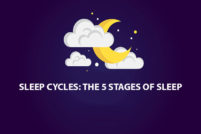First, know you’re not alone: More and more people are reporting that they too experience these bizarre sensations that have come to be known as the Autonomous Sensory Meridian Response (ASMR).
But what is ASMR, and what causes it? Or, for that matter, what does it do?
There are many benefits to the experience of ASMR, from reducing stress levels to helping you get a better night’s sleep. Whether you’re someone who has always experienced this effect, or you’re interested in learning how to unlock this mysterious phenomenon we have the answers for you.
What Is ASMR?
Autonomous sensory meridian response (ASMR) is a bizarre phenomenon that has only recently begun to gain mainstream recognition. Although difficult to describe, ASMR is a physical and emotional response to a gentle stimulus. People describe a variety of different sensations, all of which promote a sense of calm and relaxation.
“ASMR is a physical and emotional response to a gentle stimulus.”
While not much is known about the prevalence of ASMR, from personal reports it appears that the effect is universal: Affecting people of all ages from every corner of the world. While the majority of people who do respond to ASMR do so from a very early age, others only become aware of the comforting sensations later on in life.
There is still a debate about whether ASMR is an innate quality (something you have to be born with) or something you can train yourself to experience (akin to meditation). Regardless, the effect has garnered quite the fanbase, and its proponents believe that ASMR is useful in treating anxiety, depression and sleep disorders.

via asmr-massage.com
What Does ASMR Feel Like?
ASMR is both a physical and psychological experience, with the exact sensations accompanying the effect varying between individuals. However, if you’re wondering if you’ve experienced ASMR there are some hallmark “symptoms” that have come to define it:
Physical Sensations of ASMR
The physical sensations accompanying ASMR are typically felt in the head and scalp, but can radiate into the neck and shoulders, and even travel down to the base of your spine. Some people also experience these sensations in their limbs.
- Tingles
- Chills
- Waves
Psychological Sensations of ASMR
There’s no doubt that it’s the psychological effects that accompany the physical sensations that drive people to seek out the experience. These can vary just as much as the physical, but they are always pleasant.
- Calmness
- Happiness
- Euphoria
- Relaxation
- Sleepiness
What distinguishes ASMR is that these effects result from a stimulus that is perceived as gentle or soothing. These can be as mundane as a steady beat or the texture of a certain object, to complex reenactments of experiences such as a visit to the salon.
How To Experience ASMR
There are two ways people go about experiencing ASMR. The most common is through the use of an external stimulus, while others use their imagination and meditation techniques to create internal stimuli.
While these days when we think of ASMR it likely conjures up images of the YouTube videos that have brought the phenomenon into the spotlight. However, you can unintentionally experience ASMR if you’re exposed to a stimulus while going about your routine activities. In fact, most people first become aware of ASMR through these accidental occurrences.
There are different categories of ASMR triggers, and most people will find they respond strongly to one while having a muted or even no reaction to others.
ASMR Triggers
Visual
- Eye contact
- Hand movements
- Writing
- Page flipping
- Specific scenes
Auditory
- Spoken
-
Whispering
-
Monotone
-
High/low pitch
- Chewing
- Blowing
- Tapping
- Scratching
- Crinkling
Tactile
- Textures
- Light touch and massage
- Playing with hair
- Grooming
As you can see, there a lot of different stimuli that can evoke an ASMR response; however, they all generally share some common traits. They are gentle, repetitive, performed at a steady pace, methodical, have a low or sustained volume and are non-threatening.
People who elicit an ASMR effect in others (whether intentionally through the creation of ASMR content or unintentionally) usually display certain traits during the interaction. They’re often described as being caring and kind, empathetic, attentive, trustworthy and calm.
According to a survey, the most common ASMR triggers are whispering, slow and repetitive movements, smiling, crisp sounds and personal attention. Researchers argue that the most effective ASMR stimuli involve the subject being attended to in some way: whether through grooming or examination by a doctor.
ASMR Videos: Scenarios and Role-Plays
ASMR videos combine multiple common triggers in order to produce very strong a very strong effect. These are typically delivered in the form of a scenario or role-play that involve methodical task completion, instructional demonstrations, consultations or personal attention.
These videos also may be filmed and presented in a way so that the viewer feels as if they are the recipient of certain actions.
Examples of ASMR Scenarios:
- Spa or salon visit
- Paper folding
- Unboxing
- Doctor’s visit
What Causes ASMR Response?
Research into the realm of ASMR is still in its infancy, so we simply don’t have all the answers yet. However, there is one prevailing theory as to what is behind this bizarre phenomenon: That it’s activating our built-in pathways of interpersonal bonding.
As we mentioned, ASMR triggers often involve a sense of being cared for or attended to. The effect is also typically elicited by people possessing a certain gently, caring disposition. Researchers hypothesize that these events may activate the areas of the brain involved in forming close interpersonal bonds — such as that between parent and child.
Both animal and human studies have shown that specific behaviors involved in the bonding process (even just being in the company of a loved one) stimulate the release of endorphins, dopamine, oxytocin and serotonin. These neurochemicals result in feelings of pleasure, sedation, relaxation and even inhibit pain.
The sensation of calm and comfort that results from ASMR can likely be attributed to a similar cocktail of neurochemicals being released:
Endorphins
- Responsible for bringing on the tingling sensations and sense of euphoria.
- Stimulates the release of dopamine.
Oxytocin
- The “bonding hormone:” Oxytocin increases feelings of trust and contentment, while decreasing fear.
- The main cause of the sensations of relaxation and comfort.
- Increases the sensitivity of endorphin receptors.
- Stimulates the release of serotonin.
Dopamine
- Motivates you to seek out and focus on stimuli that trigger endorphin release.
- What keeps you watching a video despite it appearing mundane or uninteresting.
Serotonin
- Brings on a sense of satisfaction and well-being.
- The primary cause of elevated mood.
Another less popular theory is that ASMR is similar to Synesthesia — an equally poorly understood phenomenon which causes a stimuli to be “experienced” by several senses simultaneously. For example, upon listening to music someone with synesthesia may see vivid colors associated with each note.
Of course, there are also more mystical explanations for the experience: Some believe ASMR activates your “third eye,” while others go as far as to say it’s the “next stage of human consciousness.”
Why Do Only Certain People Experience ASMR?
Whether or not everyone is capable of experiencing ASMR is still up for debate. Some people believe it’s just a matter of finding what triggers work for you, whereas others think it comes down to your biology.
Everyone (unless you have specific medical conditions) is capable of producing the neurochemicals believed to be responsible for the ASMR effect; what differs is how strong a stimulus has to be for you to “feel” it.
“Everyone is capable of producing the neurochemicals believed to be responsible for the ASMR effect.”
Think about it as being akin to individual differences in other perceptions. For an example, let’s use sugar: some people only need a tiny amount of sugar to experience the sensation of “sweet,” while others need to dump in teaspoon after teaspoon before they’re satisfied.
ASMR may work similarly: Some of us may only release enough of the relevant neurochemicals in response to a strong stimulus (such as being comforted by a loved one), while others have a lower threshold that produces an effect in response to weaker stimuli (like an ASMR video).
Thus it does appear that genetic differences play a role in whether or not you experience ASMR. Does that mean you can’t train yourself to experience it?
For an answer we can look to what we know about the neurochemicals presumed to be behind ASMR. Receptors in our brain are known to become less sensitive with repeated exposure to the same stimulus. This is why certain medications — such as hypnotics, sedatives and painkillers — require long-term users to take a larger dose to get the same effect.
So, it would seem that if you’re interested in trying to experience ASMR you could “train” your brain by repeatedly exposing yourself to common ASMR triggers. According to experts, you can also increase your chances of success by ensuring the conditions are optimal:
- Choose an environment that you find safe and relaxing.
- Get into a comfortable position (lying down is the best).
- Clear your mind with breathing exercises or meditation.
And of course, do a little research to find what ASMR trigger speaks to you.
What Are The Health Benefits Of ASMR?

If you experience ASMR then you can and should use this to your advantage. There are many benefits to the ASMR effect: from helping to relieve stress and promote sleep, to aiding in the treatment of mental illnesses and chronic pain.
Since researchers are still figuring out the biological basis of ASMR, there is a lack of clinical evidence for the effectiveness of the phenomenon as a treatment option. However, countless self-reports — as well as just experiencing it for yourself — provides us with a more intuitive picture of how harnessing this effect can improve your general wellbeing.
ASMR is defined by its effect: A positive experience characterized by sensations of relaxation and comfort. In this way, ASMR is a great self-soothing tool; and, in contrast with medications or other methods of self-sedation (such as alcohol and cigarettes) it has no negative side-effects.
ASMR For Sleep

Perhaps the most frequently named use of ASMR content is for help falling asleep. Whether your sleep problems are due to insomnia, or you just have a hard time shutting down at the end of your day, ASMR can get you in the right physical and mental state for sleep.
ASMR videos are very similar to guided meditation which has been scientifically proven to help resolve sleep disturbance. The additional physical sensations that accompany ASMR can also help to draw your attention away from anything weighing on your mind, and soothes muscle tension. A whopping 80% of ASMR fans reported that they turn to videos to help them sleep.
A quick YouTube search will turn up thousands upon thousands of ASMR videos — many of which are specifically designed to help you fall asleep faster and sleep deeper. There are also many audio-only ASMR recordings that you can access on services such as Spotify or download for free.
How you decide to set-up your bedtime ASMR routine will depend on personal preference as well as which stimuli you require to experience the effect. For example, if auditory stimuli are your most powerful triggers, you can easily tuck into bed with a pair of headphones and allow yourself to drift off to sleep. Others may prefer to indulge in an ASMR video in a comfortable seated position before tucking in for the night.
The most important thing is to find what works for you and simply allow yourself the time to relax before bed.





